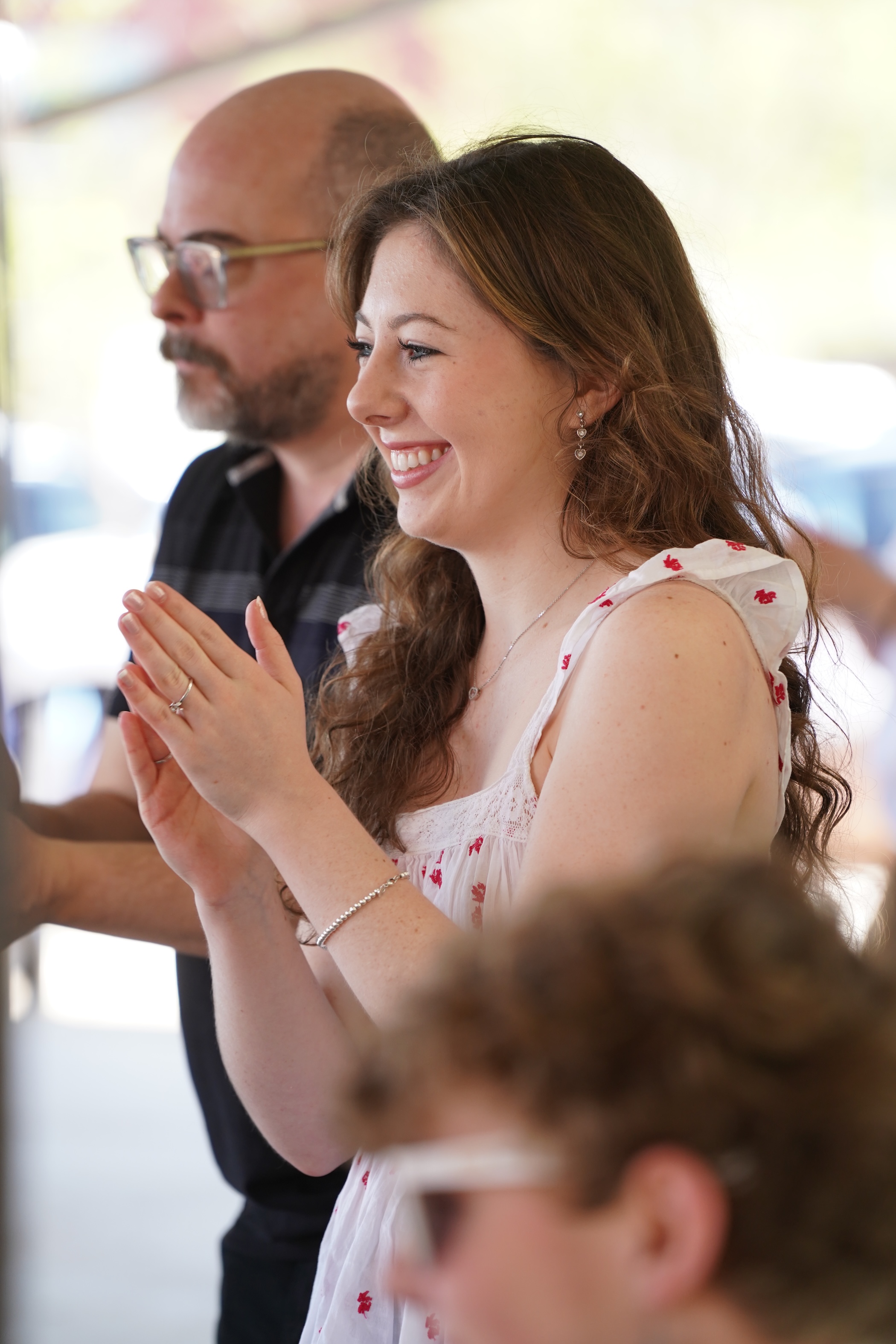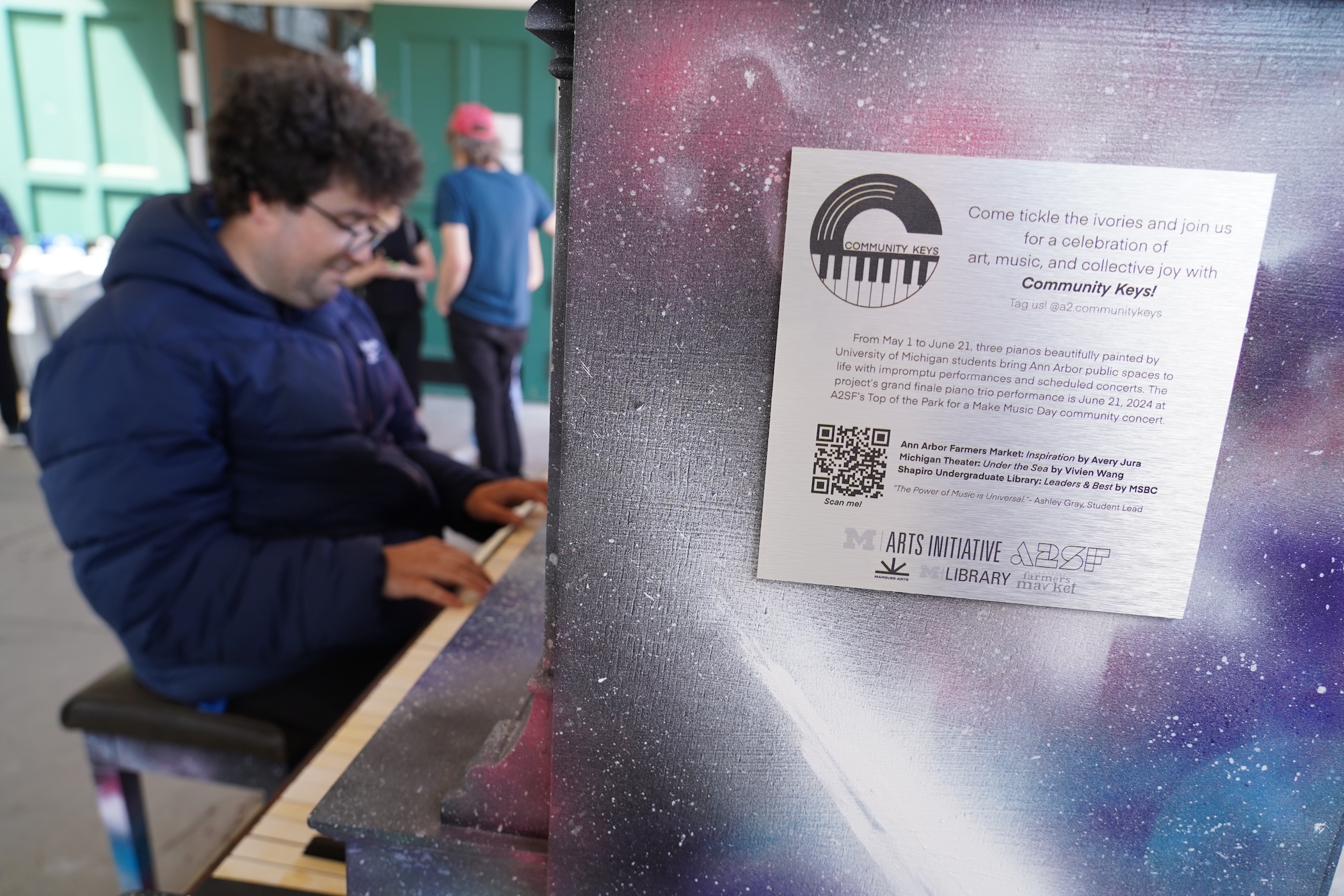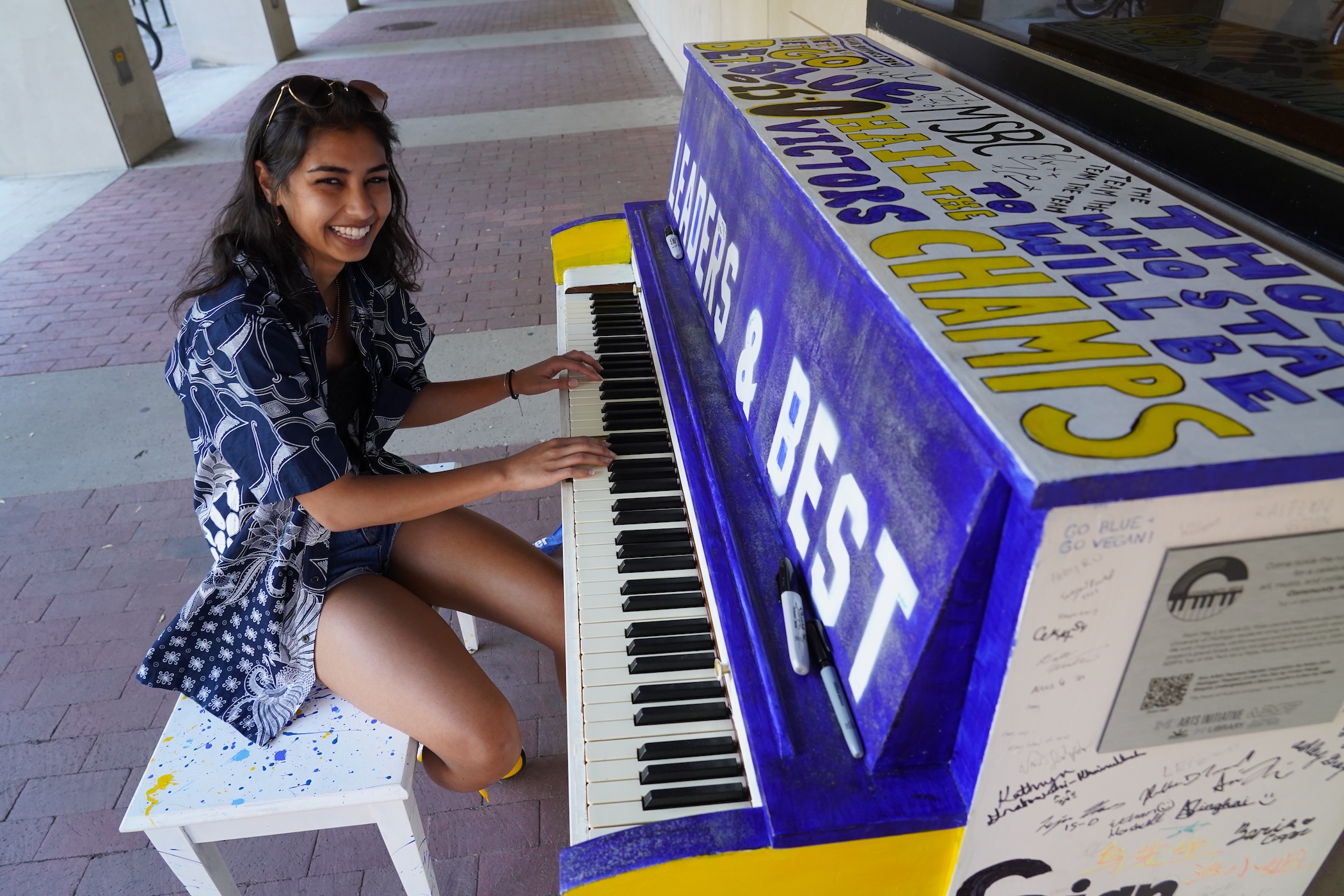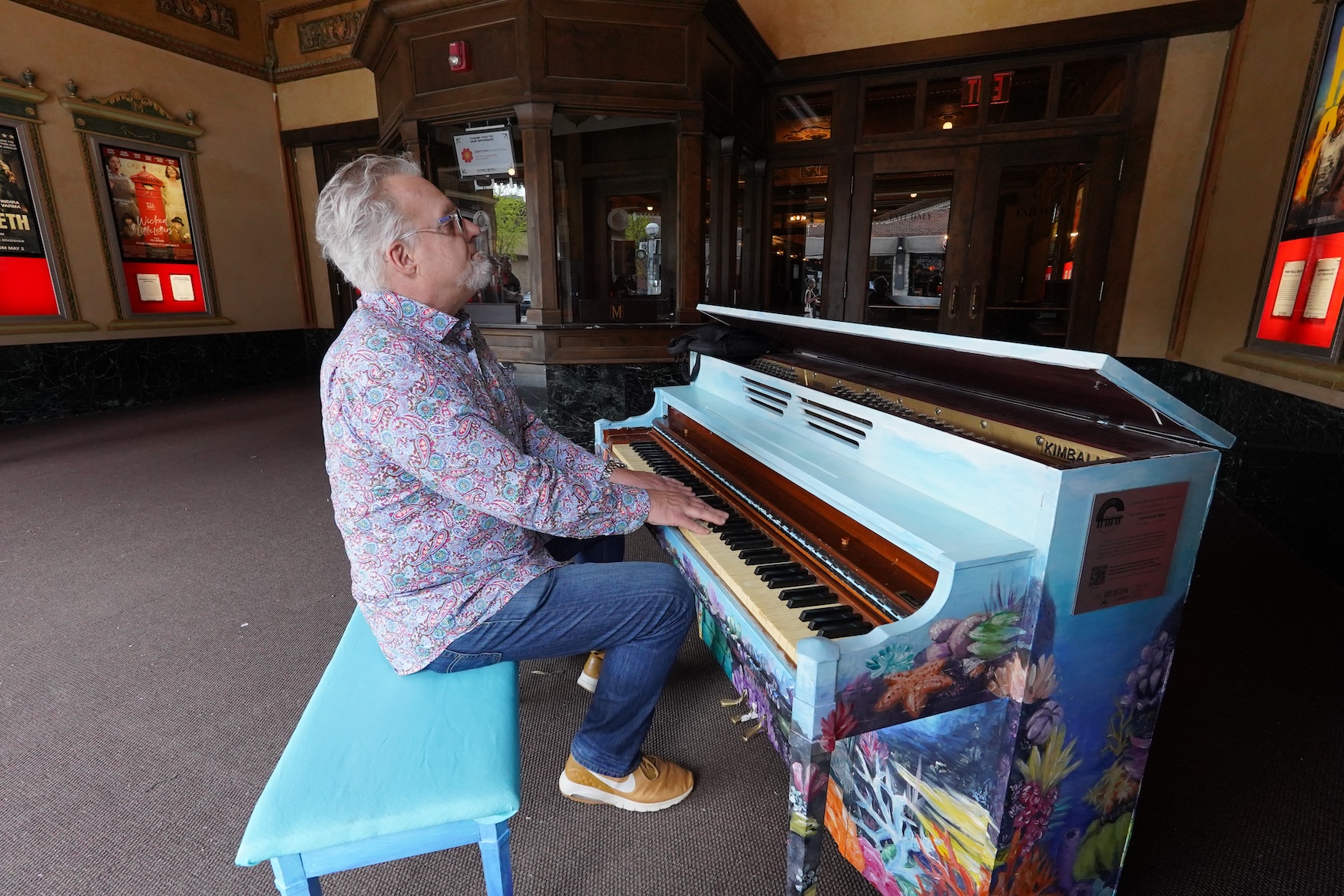
 Back to News
Community Impact
|
Student Success
Back to News
Community Impact
|
Student Success
Movement science student’s public art project brings music — and joy — to Ann Arbor

On May 1, a galaxy-themed piano appeared at the Ann Arbor Farmers Market. A second piano, painted with images of an underwater seascape, surfaced in front of the Michigan Theater. A third materialized outside of the Shapiro Undergraduate Library — covered with words and stencils but with space for others to add their own mark to the wood.
The pianos make up Community Keys, a project involving a School of Kinesiology student, the U-M Arts Initiative, and the Ann Arbor Summer Festival (A2SF) that enables anyone to bring music to the streets of Ann Arbor and the University of Michigan campus. The pianos are available to play until June 19, after which they’ll be featured in an A2SF performance at Top of the Park on June 21.
“Music is universal,” says Ashley Gray, the rising junior and movement science major who launched the project. “And it’s healing.”
Keeping art in her life

Gray began playing piano at 4 years old. As she grew up, she continued taking lessons while delving into drawing, painting, and photography.
When she was a senior in high school, her hometown of Danville, Calif., was planning to place pianos around town and looking for artists to paint the instruments. Gray didn’t need to think twice about applying.
Not long after, she finished her piano, which was inspired by the Summer of Love. She painted swirls of psychedelic colors, peace signs, flowers, and, above the keybed, a request for passersby: “PLAY ME.”
People did. They’d filter out of the nearby Veterans Memorial Building, or the local ice cream shop, or the Starbucks, and try out a rendition of “Chopsticks” or “Heart and Soul,” with crowds inevitably gathering to enjoy the music.
So when Gray came across the Arts Initiative’s call for projects in early January 2023 — particularly collaborative ones that bridged the gap between non-arts and arts students — she decided she’d like to bring a bit of that Danville magic to Ann Arbor.
“I’ve always wanted to keep art in my life somehow,” Gray says. “I haven’t found the time to play or practice piano, and this is one way I can keep it in my life.”
Just as important as school

In her free time, Gray put together a proposal, spiffing up the timeline and the budget with her graphic design skills.
Time passed. She didn’t hear anything. It was just an idea, she thought, so it was OK if this is where it ended.
Then, while home for the summer, Gray found out the Arts Initiative had awarded her a grant of about $15,000 to put Community Keys together.
To help her, Gray brought on two partners: Kathryn Grabowski-Khairullah, the program curator of the Arts Initiative, and James Carter, the associate director of A2SF. Carter worked to secure the sites for the pianos while Grabowski-Khairullah and Gray searched for the instruments themselves.
“I could not have done this without them, at all,” Gray says.
They collaborated with three sites: the Ann Arbor Farmers Market, the Shapiro Undergraduate Library, and the Michigan Theater.
They sourced three pianos: a 1975 Baldwin from the Washington Street Education Center in Chelsea (that’s at the library); a 1948 Kimball from a donor in Ann Arbor (now playing at the Michigan Theater); and a 1911 Huntington manufactured in Detroit (currently at the farmers market).
They planned student performances to take place at noon on Saturdays and Wednesdays, as well as the pianos’ grand finale during A2SF.
Carter recently told Gray that if she ever decided not to become a doctor, “she has a career in producing art,” he says. “She’s a really smart person, very organized, but also has a great eye.”
"It never felt like an extra thing that she was doing, an extracurricular thing,” he continues. “It felt like it was just as important to her as school.”
For Gray, though, there ended up being a connection between school and Community Keys. One of the three artists she found to paint the pianos was Navya Singhai, a movement science and sport management double major and the chief people officer of the Michigan Sport Business Conference (MSBC), an SoK student organization.
Singhai and other members of MSBC worked together to create a “Leaders & Best'' piano that would represent their organization’s mission to create a community within sports. Painted on the piano’s side is a question: “What’s your legacy?” Anyone walking by can grab a nearby Sharpie and write an answer on the wood.

“We took the community theme of the piano and the intention of this project,” Singhai says, “and ran with it.”
Defying the order of our society
Every time Singhai walks past the MSBC piano, there is music. It’s the same around campus and the city; someone always seems to be playing the pianos, to the surprise and delight of multiple people who have reached out to the organizers to express how the music has brightened their days.
“The whole concept of being able to bang on an instrument in a public place defies the order of our society, in a way,” Grabowski-Khairullah says. “It shakes up your everyday idea of what the rules and regulations are, and where you belong, and what you have access to, and what you should touch, and how loud you should be.”
Consider society defied, then, by the woman who used a looping machine to create a backing track alongside her impromptu piano performance. Or by Mr. B, the local boogie-woogie pianist who pulled a football player over to listen to him perform hundred-year-old tunes.

Or by Gray herself. Not long after the pianos made their debut, she was walking with some kinesiology friends when they were caught in a sudden rainstorm. They ran down State Street and found cover underneath the Michigan Theater marquee.
They sat down at the piano, soaking wet, and one of Gray’s friends began playing “Don’t Stop Believin’.”
“Just a small-town girl…”
The Journey song, amplified by the theater’s bandshell facade, boomed into the street.
“… Streetlights, people …”
The students belted out the tune.
“… Hidin’ somewhere in the niiiiiight.”
Photos by Erin Kirkland/Michigan Photography and Peter Smith